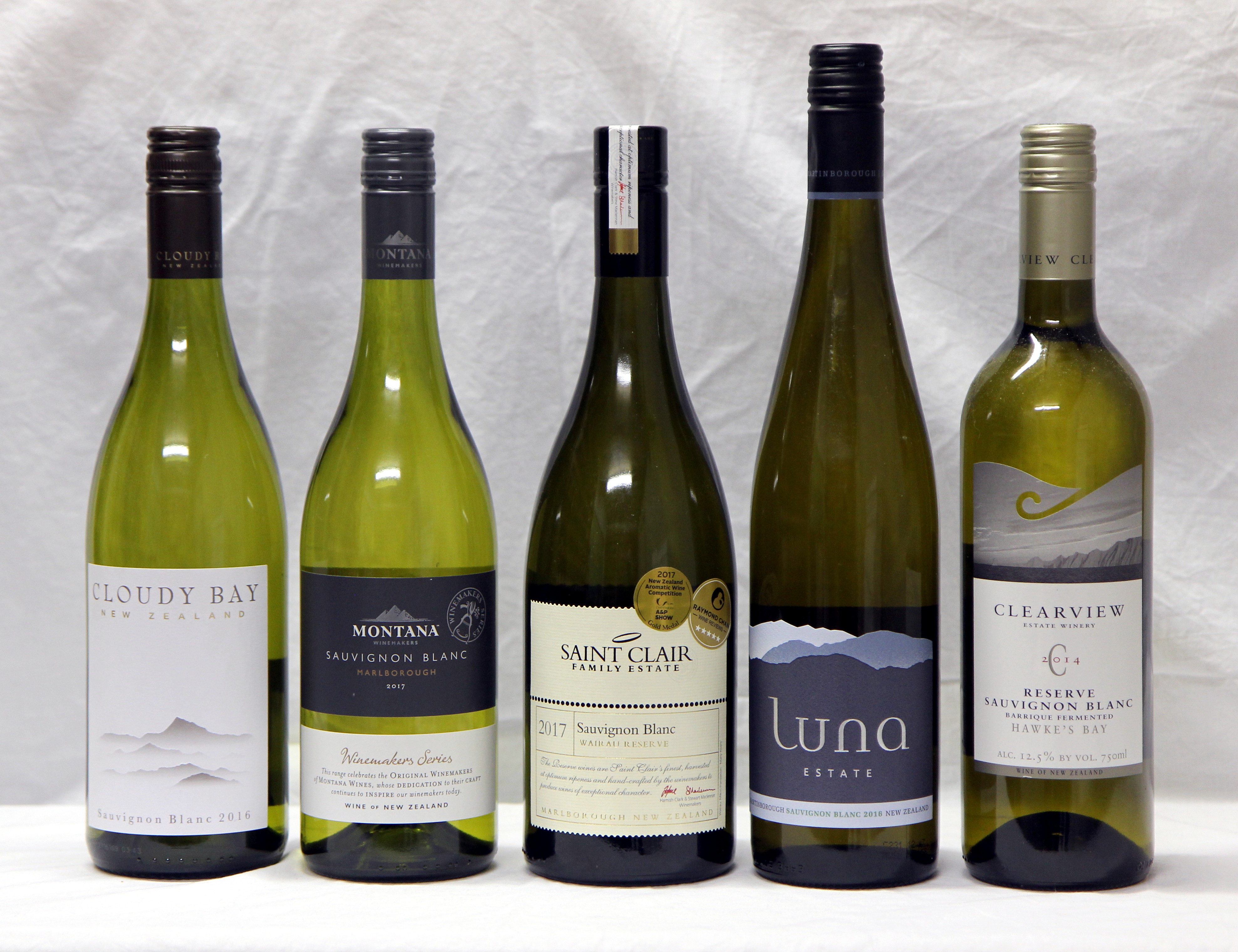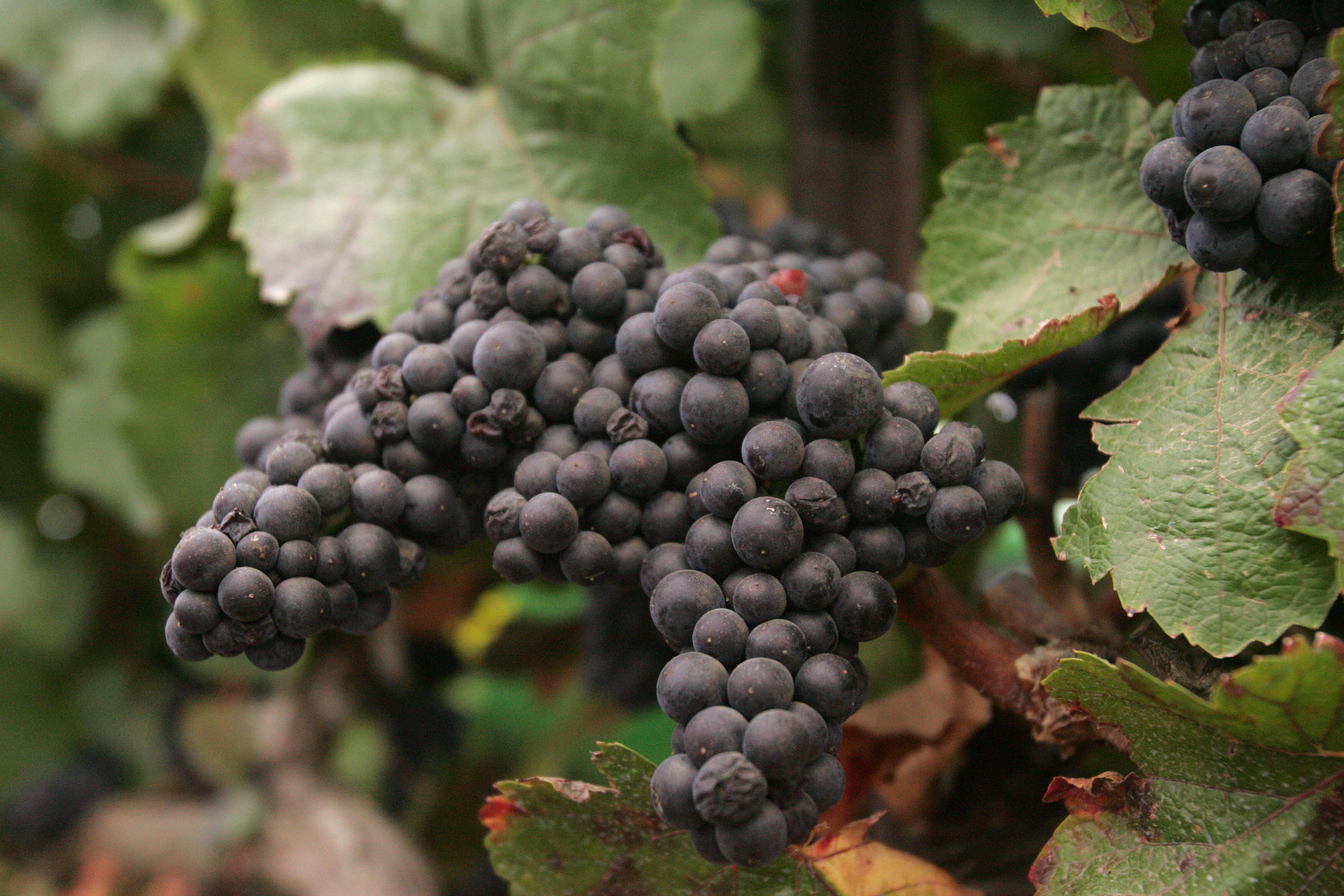|
Syrah
Syrah (), also known as Shiraz, is a dark-skinned grape variety grown throughout the world and used primarily to produce red wine. In 1999, Syrah was found to be the offspring of two obscure grapes from southeastern France, Dureza and Mondeuse Blanche. Syrah should not be confused with Petite Sirah, a cross of Syrah with Peloursin dating from 1880. The style and flavor profile of wines made from Syrah are influenced by the climate where the grapes are grown. In moderate climates (such as the northern Rhone Valley and parts of the Walla Walla AVA in Washington State), they tend to produce medium to full-bodied wines with medium-plus to high levels of tannins and notes of blackberry, mint and black pepper. In hot climates (such as Crete, and the Barossa Valley and McLaren Vale regions of Australia), Syrah is more consistently full-bodied with softer tannin, jammier fruit and spice notes of licorice, anise and earthy leather. In many regions the acidity and tannin le ... [...More Info...] [...Related Items...] OR: [Wikipedia] [Google] [Baidu] |
Rhône Wine
The Rhône wine region in Southern France is situated in the Rhône valley and produces numerous wines under various ''Appellation d'origine contrôlée'' (AOC) designations. The region's major appellation in production volume is Côtes du Rhône AOC. The Rhône is generally divided into two sub-regions with distinct vinicultural traditions, the Northern Rhône (referred to in French as ''Rhône septentrional'') and the Southern Rhône (in French ''Rhône méridional''). The northern sub-region produces red wines from the Syrah grape, sometimes blended with up to 20% of white wine grapes, and white wines from Marsanne, Roussanne and Viognier grapes. The southern sub-region produces an array of red, white and rosé wines, often blends of several grapes such as in Châteauneuf-du-Pape. History The first cultivated vines in the region were probably planted around 600 BC. The origins of the two most important grape varieties in the northern Rhone (Syrah and Viognier) have in the ... [...More Info...] [...Related Items...] OR: [Wikipedia] [Google] [Baidu] |
Dureza
Dureza is a dark-skinned French wine grape variety from the Ardèche department of south central France in the Auvergne-Rhône-Alpes region. The grape is most widely known for being the father vine of Syrah—a discovery that confirmed that the Syrah vine was native to France and not introduced to the country from Persia (wine), Persia, Sicily, Egypt or elsewhere, as had been speculated.J. Robinson, J. Harding and J. Vouillamoz ''Wine Grapes - A complete guide to 1,368 vine varieties, including their origins and flavours'' pgs XXVII, 316, 528 & 1023, Allen Lane 2012 Dureza was historically used for production of red wine, but is hardly grown any more and is not part of the list of the allowed grape varieties of any French ''Appellation d'origine contrôlée'' wine, though it can be produced under some ''vin de pays''. There were only 11 hectares planted to Dureza in the late 1970s: by 1988 only one hectare remained. However, since the variety's relationship to Syrah was reveale ... [...More Info...] [...Related Items...] OR: [Wikipedia] [Google] [Baidu] |
New Zealand Wine
New Zealand wine is produced in several of its distinct winegrowing regions. As an island country in the South Pacific Ocean, New Zealand has a largely maritime climate, although its elongated geography produces considerable regional variation from north to south. Like many other New World wines, New Zealand wine is usually produced and labelled as single varietal wines, or if blended, winemakers list the varietal components on the label. New Zealand is best known for its Marlborough Sauvignon Blanc, and more recently its dense, concentrated Pinot Noir from Marlborough, Martinborough and Central Otago. While New Zealand wine traces its history to the early 19th century, the modern wine industry in New Zealand began in the mid-20th century and expanded rapidly in the early 21st century, growing by 17% a year from 2000 to 2020. In 2020, New Zealand produced from of vineyard area, of which ha (about two-thirds) is dedicated to Sauvignon Blanc. Nearly 90% of total productio ... [...More Info...] [...Related Items...] OR: [Wikipedia] [Google] [Baidu] |
Petite Sirah
Durif is a variety of red wine grape mainly grown in Australia, California, France, and Israel. Since the end of the 20th century, wineries located in Washington (state), Washington's Yakima River Valley, Maryland, Arizona, Texas, West Virginia, Chile, Mexico's Baja California Peninsula, and Ontario's Niagara Peninsula have also produced wines from Durif grapes. It is the primary grape known in the U.S. and Israel as Petite Sirah, with over 90% of the California plantings labeled "Petite Sirah" being Durif grapes. The United States, U.S. Bureau of Alcohol, Tobacco, Firearms and Explosives (ATF) recognizes "Durif" and "Petite Sirah" as synonyms.PS I Love YoPetite Sirah Timeline The grape produces tannin (wine), tannic wines with a spicy, plummy flavour. It originated from Syrah pollen germinating a Peloursin plant. On occasion, Peloursin and Syrah vines may both be called Petite Sirah, usually because the varieties are extremely difficult to distinguish in old age. History In ... [...More Info...] [...Related Items...] OR: [Wikipedia] [Google] [Baidu] |
Côte-Rôtie AOC
Côte-Rôtie () is a French wine ''Appellation d'origine contrôlée'' (AOC) in the northern Rhône wine region of France. The vineyards are located just south of Vienne in the communes of Saint-Cyr-sur-le-Rhône, Ampuis, and Tupin-et-Semons.Inter Rhône: Côte-Rôtie Retrieved 19 January 2010 The vineyards are unique because of the steep slopes facing the river and their stone walls. ''Côte-Rôtie'' can be rendered in English as "the roasted slope" and refers to the long hours of sunlight that these steep slopes receive.E. McCarthy & M. Ewing-Mulligan ''"French Wine for Dummies"'' pg 127-128 Wiley Publishing 2001 The wines are red, made with |
Peloursin
Peloursin is red French wine grape variety best known for crossing with Syrah to make the red wine grape Durif (known in the United States as Petite Sirah).J. Robinson ''"The Oxford Companion to Wine"'' Third Edition pg 510 Oxford University Press 2006 Eric Asimov 'Petite Sirah's Extra Large Wallop'' ''The New York Times'' January 5th, 2005 The variety is believed to have originated in Isère from the northern Rhône-Alpes region. Today Peloursin can be found in some quantities in California and in the Australia wine region of Victoria.J. Robinson ''Vines, Grapes & Wines'' pg 228 Mitchell Beazley Publishing 1986 History Ampelographers believe that Peloursin originated in the Isère department near Grenoble somewhere along the Vallée du Grésivaudan. The name ''Peloursin'' likely derives from the local word ''pelossier'' used to describe the blackthorn trees that populate the area and whose fruit the Peloursin grapes have a slight resemblance to. At some point the grape ... [...More Info...] [...Related Items...] OR: [Wikipedia] [Google] [Baidu] |
Australia (wine)
The Australian wine industry is one of the world's largest exporters of wine, with approximately 800 million out of the 1.2 to 1.3 billion litres produced annually exported to overseas markets. The wine industry is a significant contributor to the Australian economy through production, employment, export, and tourism. There is a $3.5 billion domestic market for Australian wines, with Australians consuming approximately 500 million litres annually. Norfolk Islanders are the second biggest per capita wine consumers in the world with 54 litres. Only 16.6% of wine sold domestically is imported. Wine is produced in every state, with more than 60 designated wine regions totalling approximately 160,000 hectares; however Australia's wine regions are mainly in the southern, cooler parts of the country, with vineyards located in South Australia, New South Wales, Victoria, Western Australia, Tasmania and Queensland. The wine regions in each of these states produce different win ... [...More Info...] [...Related Items...] OR: [Wikipedia] [Google] [Baidu] |
Mondeuse Blanche
Mondeuse blanche () is a variety of white grape almost exclusively found in and around the Savoy wine, Savoy (Savoie) wine region in France. With just of plantations in 1999, it leads a dwindling existence and is used primarily in the VDQS wine Bugey VDQS, Bugey and the Appellation d'origine contrôlée, AOC Vin de Savoie. Related grapes Some studies have suggested that Mondeuse blanche is a parent of Syrah. However, more recent, long-read sequencing of the Syrah/Shiraz genome suggests that this relationship may be more complex than parent-offspring (Onetto et al. 2022). Despite their similarity in names, Mondeuse blanche is not closely related to Mondeuse noire, or Mondeuse gris. Grapes just called Mondeuse are usually Mondeuse noire rather than Mondeuse blanche. In the 20th century, ampelographers Louis Levadoux and (decades later) Linda Bisson categorized Mondeuse blanche as a member of the Peloursin eco-geogroup along with Bia blanc, Béclan, Dureza, Exbrayat, Durif, Ja ... [...More Info...] [...Related Items...] OR: [Wikipedia] [Google] [Baidu] |
Hermitage AOC
Hermitage () is a French wine ''Appellation d'Origine Contrôlée'' (AOC) in the northern Rhône (wine region), Rhône wine region of France south of Lyon. It produces mostly red wine from the Syrah grape; however, small quantities of white wine are also produced from Roussane and Marsanne grapes. The hill is seen by some as the spiritual home of the Syrah grape variety. History According to legend, the Knight Gaspard de Stérimberg returned home wounded in 1224 from the Albigensian Crusade and was given permission by the Queen of France to build a small refuge to recover in, where he remained living as a hermit (''ermite'' in French). The chapel on top was built in honor of Saint Christopher and today is owned by the negociant Paul Jaboulet Âiné. Louis XIII made the wine a wine of the court after being offered a glass during a visit to the region in 1642. Louis XIV presented King Charles II of England with 200 casks of fine wine including examples from Hermitage, Champagne ( ... [...More Info...] [...Related Items...] OR: [Wikipedia] [Google] [Baidu] |
Walla Walla AVA
Walla Walla Valley is an American Viticultural Area (AVA) located within Washington state and extending partly into the northeastern corner of Oregon. The wine region is entirely included within the larger Columbia Valley AVA. In addition to grapes, the area produces sweet onions, wheat and strawberries After the Yakima Valley AVA, the Walla Walla AVA has the second highest concentration of vineyards and wineries in Washington State. Walla Walla hosts about 140 wineries. The area was recognized on March 7, 1984 by the Bureau of Alcohol, Tobacco and Firearms (ATF), Treasury after reviewing the petition submitted by Mr. Richard L Small, President of the Walla Walla Valley Winegrowers Association, for the establishment of a viticultural area in southeast Washington and northeast Oregon, east of Lake Wallula, to be known as "Walls Walls Valley." At the time, Walla Walla Valley viticultural area was approximately with two bonded wineries and about from several vineyards. Name ... [...More Info...] [...Related Items...] OR: [Wikipedia] [Google] [Baidu] |
Barossa Valley (wine)
The Barossa Valley wine region is one of Australia (wine), Australia's oldest and most premier wine regions.K. MacNeil ''The Wine Bible'' pg 792 Workman Publishing 2001 Located in South Australia (wine), South Australia, the Barossa Valley is about 56 km (35 miles) northeast of the city of Adelaide. Unlike most of Australia whose wine industry was heavily influenced by the British (people), British, the wine industry of the Barossa Valley was founded by German settlement in Australia, German settlers fleeing persecution from the Prussian province of Silesia (in what is now Poland). The warm continental climate (wine), continental climate of the region promoted the production of very ripe grapes that was the linchpin of the early Australian fortified wine industry. As the modern Australian wine industry shifted towards red table wines (particularly those made by the prestigious Cabernet Sauvignon) in the mid-20th century, the Barossa Valley fell out of favor due to its reput ... [...More Info...] [...Related Items...] OR: [Wikipedia] [Google] [Baidu] |
France (wine)
French wine is produced throughout all of France in quantities between 50 and 60 million hectolitres per year, or 7–8 billion bottles. France is one of the largest wine producers in the world. French wine traces its history to the 6th century BCE, with many of France's regions dating their wine-making history to Roman times. The wines produced range from expensive wines sold internationally to modest wines usually only seen within France such as the Margnat wines of the post-war period. Two concepts central to the better French wines are the notion of ''terroir'', which links the style of the wines to the locations where the grapes are grown and the wine is made, and the Protected designation of origin (''Appellation d'Origine Protégée'', AOP) system, named ''Appellation d'origine contrôlée'' (AOC) until 2012. Appellation rules closely define which grape varieties and winemaking practices are approved for classification in each of France's several hundred ge ... [...More Info...] [...Related Items...] OR: [Wikipedia] [Google] [Baidu] |








